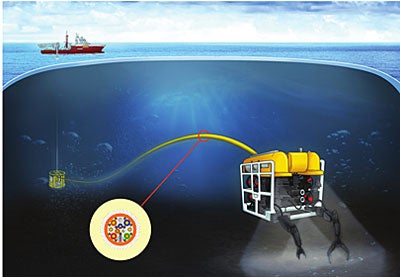
Nexans has launched Enable®, an innovative range of remote operated vehicle (ROV) tether cables that enable ROVs to work longer and harder by incorporating bending-optimised Dyneema® fibre as the strength member.
The launch, reported at the Underwater Intervention 2013 conference in New Orleans, offers a major increase in the bending fatigue resistance of tether cables, which is an important step towards more cost-effective ROV operations.
Tether is a flexible, lightweight cable
The tether cable is a flexible, lightweight cable that provides the physical connection between the ROV and its tether management system (TMS), transmitting electrical power and optical signals and carrying mechanical payloads. During operation, the cable is subjected to small bending diameters and relatively sharp directional changes in the TMS as well as vehicle motions. This causes the synthetic fibres used as the strength member to mechanically deteriorate, resulting in the need for regular re-termination of the ROV tether cable.
High-performance bending-optimised fibres
The key innovation in the development of the Enable® cables is that the aramid fibres previously used as the strength member have been replaced by high-performance bending-optimized Dyneema® fibres. Extensive fatigue testing has demonstrated that the new Enable®cables have a bending durability that is several orders of magnitude better than conventional cables.
Prolonged mechanical lifetime
Improved bending performance offers a number of operator advantages
ROV operators can utilize the improved bending performance of Enable® cables in a number of ways, depending on their strategy. It is immediately apparent that they can ensure a prolonged mechanical lifetime when deployed on existing systems, with the increased intervals between re-terminations offering more cost-effective operations. Enable® cables could also offer a similar mechanical lifetime on smaller systems.
Greater flexibility in the design of ROV tethers
Furthermore, the use of the bending-optimized strength element offers greater flexibility in the design of ROV tethers in the range of 20 to 45 mm outer diameter. One option is to use fewer strength members to reduce the overall outer diameter. Another alternative is to use the reduction in specific weight offered by the Dyneema® fibres to incorporate more copper conductors, reducing voltage drop to achieve longer excursion lengths.

